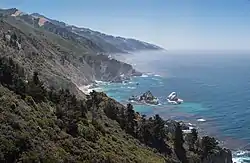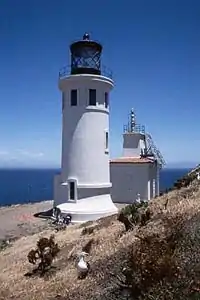Point Sur Lighthouse
Point Sur Lightstation is a lighthouse at Point Sur, California, 135 miles (217 km) south of San Francisco, on the 361-foot (110 m)-tall rock at the head of the point. It was established in 1889 and is part of Point Sur State Historic Park. The light house is 40 feet (12 m) tall and 270 feet (82 m) above sea level. As of 2016, and for the foreseeable future the light is still in operation as an essential aid to navigation. Point Sur is the only complete turn-of-the-20th-century lightstation open to the public in California.[5] Three-hour walking tours guided by volunteers are available on Wednesdays and weekends throughout the year.
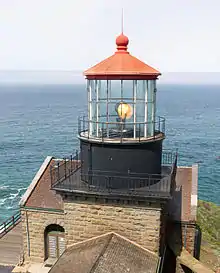 Point Sur Light in 2013 | |
 California | |
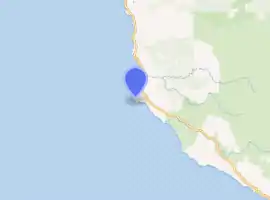
| |
| Location | Point Sur State Historic Park California United States |
|---|---|
| Coordinates | 36°18′22.79″N 121°54′05.36″W |
| Year first constructed | 1889 |
| Automated | 1972 |
| Construction | sandstone tower |
| Tower shape | square tower with balcony and lantern attached to fog signal building |
| Markings / pattern | unpainted tower, black lantern |
| Tower height | 48 ft (15 m) |
| Focal height | 270 ft (82 m) |
| Original lens | First order Fresnel lens |
| Current lens | DCB-224 |
| Characteristic | Fl W 15s. |
| Fog signal | 2 blasts every 60 |
| Admiralty number | G3988 |
| USCG number | 6-0280 |
| Managing agent | Point Sur State Historic Park[1] [2] |
| Heritage | place listed on the National Register of Historic Places |
Point Sur Light Station | |
| Nearest city | Big Sur, California |
| Area | 37 acres (15 ha) |
| Architectural style | Renaissance, Romanesque, Lighthouse |
| MPS | Light Stations of California MPS |
| NRHP reference No. | 91001097[4] |
| CHISL No. | 951[3] |
| Added to NRHP | September 3, 1991 |
Construction
The point was originally over 360 feet (110 m) above sea level, and was only 10 to 12 feet (3.0 to 3.7 m) wide at the top. Part of the top was blasted off to allow for construction. To transport granite and building materials to the base of the rock, the contractor built 500 feet (150 m) of railway track and a corduroy road (constructed using wooden planks). A 395-step staircase was originally the only access by foot.
Light sources
The lighthouse has had four different light sources during its history. First, it had an oil wick lamp, and then an oil vapor lamp. Three different fuels were used: whale oil, lard oil, and kerosene. Electricity wasn't introduced to the surrounding area and light house until the 1950s.[7]
Since Point Sur was a major point used for navigation, it was equipped with first-order Fresnel lens, the largest made at the time. The lens was more than 6 feet (2 m) in diameter and 9 feet (3 m) tall. It weighed 4,330 pounds and included 16 panels of prisms, each with a bulls-eye in the center surrounded by concentric rings of prismatic glass. Its light beam could be seen to the horizon, which for the Point Sur light, at 270 feet (82 m) feet high, is 23 miles (37 km).[8][9]
The entire structure, including the pedestal and clockworks was 18 feet (5 m) tall and weighed 9,570 pounds (4,341 kg). Each ring projects the light beyond the previous one.[9]

Foghorns
In dense fog, the light beam might not be visible, so the lighthouse had a foghorn to alert ships. A coal-powered foghorn was installed when the light was used, but this labor-intensive system was replaced as soon as better technology was available. A steam-driven fog signal was installed by the turn of the century. It was fired by wood harvested from the redwoods of Big Sur. The steam boiler used about 100 cords of wood per year.[8]
Diaphone horns were placed on top of the fog-signal room from 1935 to 1960. The two horns produced a two-tone "bee-oh" sound.[8] In 1972, the "Super Tyfon Double Fog Signal," named after the giant Typhon from Greek mythology, was put into use. This system consisted of two compressed air horns sounding simultaneously, and could be heard up to 3 nautical miles (6 km) away. The modern electric tone fog signal was a 12 volt high frequency fog signal with a sound range of half a nautical mile. The high frequency was very effective in fog.
Structures
The staff of the station consisted of a head keeper and three assistant keepers. The families of the keepers lived with them at the station. The Station had a residence for the head keeper and his family, and another for the assistant keepers.
The lighthouse keepers and their families lived in isolation at Point Sur. The station included all facilities needed for them to be self-sustaining. There was a cistern which held 53,000 US gallons (200,627 l) of water (later replaced by a water tower), and a pump house which brought up water from a well in the sand flats at the base of the rocks.
There was a barn where horses and cattle were kept. The carpenter and blacksmith shop held supplies for the keepers to do their own construction, since Monterey was a full day's trip away until the Cabrillo-San Simeon Highway was completed in 1937. The lamp tower, oil room, and fog signal room were all combined into one building because of limited space.
Etymology
The land formation later known as Point Sur is visible at sea for 10 miles (16 km) and was first mentioned in the logs of Juan Rodríguez Cabrillo in 1552. Sebastian Viscaino visited the area in the early 1600s, and his 1603 map names the promontory "Punta que Parece Isla" (meaning "Point that looks like an island"). In 1769, explorer Miguel Costansó, a member of the Portolá expedition, named the point "Morro de la Trompa" because it looked like a rock in the shape of a trumpet.[10]
The name "El Sur" (meaning "The South") was first applied to a land grant named Rancho El Sur given by Governor José Figueroa to Juan Bautista Alvarado on July 30, 1834. The name of the rock was shortened to Moro Rock,[11] until the U.S. Coast Survey renamed it Point Sur in 1851.[12][10]
History
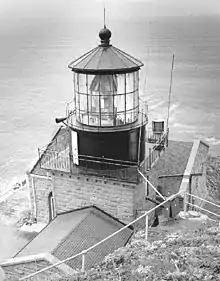
In 1793, British explorer George Vancouver described the "small, high, rocky lump of land nearly half a mile from the shore."[8] Point Sur has been a hazard to ships since California was first settled, and increased shipping traffic during the California Gold Rush beginning in 1849 caused many wrecks. In 1874, the United States Lighthouse Service (USLS) board stated,
Vessels leaving San Francisco for the south having proceeded as far as Pigeon Point Light, take their departure for Point Sur, some sixty miles distant, the great indentation of Monterey Bay intervening. Vessels to the southward bound to San Francisco having arrived at Piedras Blancas, take their departure for Point Sur again about the sixty miles distance. Hence, Point Sur is a most important point and should be the sight of a light house. In considering the various points on the California coast where lighthouses are still required Point Sur claims the place of greatest importance."[13]
In 1886, Congress finally appropriated $50,000 (equivalent to $1.42 million in 2019) for construction of a lighthouse at Point Sur. Funding ran out and construction was stopped for several months until Congress appropriated another $50,000 in 1887.[14]
Twenty-five men were employed in the construction of the lighthouse and adjacent buildings. They built a road from the mainland to the rock, blasted a trail to the top of the rock, quarried stone, and built a tramway from the shore to the peak. By the end of the first year, all the rock had been quarried and construction of many buildings was well underway. The Lighthouse Board hoped the construction would be completed by the end of 1888, but an additional $10,000 was needed. in 1887–88, Congress paid $69,100.69 to three individuals for their expenses in building the station.[15]:112
The light station was completed and the lantern lit on August 1, 1889. Life on Point Sur was very isolated. The only road, which led to Monterey, was long and often dangerous.

The U.S. Lighthouse Service provided a horse and wagon to get mail and supplies from Pfeiffer's Resort (now part of Pfeiffer Big Sur State Park). Each family was allotted a garden area for fresh vegetables. Bulk supplies such as coal, firewood, animal feed, and some food came on a 'lighthouse tender' about every four months. One function of these long, broad ships was to service remote lightstations inaccessible by land. The tender would anchor south of the lightstation and send in a 20-foot whaler towing a skiff, both loaded with supplies. The sacks and barrels were hoisted in cargo nets to a platform at the base of the rock. They were then secured to a flat railcar and winched up to the dwelling area using a steam-driven donkey engine.
Like most remote lightstations, Point Sur was very self-sufficient. As the years passed, life became increasingly less isolated at Point Sur after the completion of Highway 1 in 1937, connecting Big Sur with Monterey to the north and San Luis Obispo to the south. Prior to the construction of Highway 1, the California coast south of Carmel and north of San Simeon was one of the most remote regions in the state, rivaling nearly any other region in the United States for its difficult access.[17]
Two years later, the U.S. Coast Guard assumed responsibility for all aids-to-navigation. Lighthouse Service employees were absorbed into the new program, and allowed to become either members of the U.S. Coast Guard or remain civil service employees.
The site is now registered as California Historical Landmark #951.[3] In 1991, the old lighthouse and a 37-acre (15 ha) area was listed on the U.S. National Register of Historic Places as Point Sur Light Station.[4] In 2004, the Coast Guard transferred the building and land to California Department of Parks and Recreation.
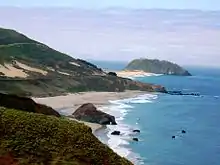
The original Fresnel lens was moved in 1978 to the Allen Knight Maritime Museum of Monterey, where it was an exhibit. The Maritime Museum ceased operation and was renamed the Museum of Monterey. The museum no longer wanted to retain the Fresnel lens as part of its collection. Interested individuals and groups began efforts to return the lens to the Point Sur Light Station. The lens is still owned by the United States Coast Guard who had to approve returning the lens. The nonprofit Central Coast Light Keepers collected more than $100,000 in donations to pay to return the lens. The project was approved in late 2017. The lens was disassembled, restored, and placed in storage until it can be moved to the lighthouse and reassembled in the lighthouse tower.[9]
Shipwrecks
Notable shipwrecks occurring near Point Sur:
With the tragedy of the SS Los Angeles, the only witnesses to the wreck were people that survived. According to the local newspaper, the captain of the Eureka, a local ferry, was the first to meet the survivors of the crash told them to keep quiet, with his intention being to keep the events of the tragedy out of the news.[19]
- December 5, 1909 -Majestic
- October 3, 1915 – Catania
- July 21, 1916 – Shna-Yak
- September 23, 1921 – G.C. Lindquer
- September 16, 1922 – Thomas Wand
- March 4, 1923 – Babinda
- April 4, 1930 Panama
- March 30, 1930 – Rhine Maru
- November 25, 1933 – Lupine
- February 13, 1935 – USS Macon (ZRS-5)
In February 1935, a navy airship known as the USS Macon (ZRS-5) crashed into the sea 10 miles out from Point Sur. Two members aboard the eighty three person crew perished that day. The cause of the incident can be traced back to the broken fin that the dirigible had near the rear of the carrier. In an attempt to stay ahead of the curve in case of another world war, the US Navy implemented a dirigible and light aircraft program. The goal of the program was to conduct long range scouting for fleet operations which would have, in theory, provided an early warning system against long range enemies.[20]
After the crash of the USS Shenandoah (ZR-1) , along with the USS Akron and Macon, the navy ended the program.[21]
- May 24, 1946 – Frank Lawrence
- October 24, 1947 – Sparrows Point
- May 14, 1956 Howard Olsen
Head lightkeepers
- James Nightwine (1889–1890)
- John F. Ingersoll (1890–1901)
- Ora O. Newhall (1901–1908)
- John W. Astrom (1908–1927)
- William Mollering (1927–1931)
- Thomas Henderson (1932–1938)
- Charles R. Coursey (1938–1944)
In popular culture
In 1967, the lighthouse (including the lantern room) and its surrounding buildings, were used as a filming location for an episode of the WWII-themed TV series, The Rat Patrol, entitled "The Two If By Sea Raid" (airdate: 12/18/67), standing in for a Nazi-held light on the Mediterranean coast of North Africa.[22]
The lighthouse was rumored to be haunted and the location was investigated by the Travel Channel Ghost Adventures paranormal reality TV show.[23]
References
- Point Sur The Lighthouse Directory. University of North Carolina at Chapel Hill. Retrieved 15 June 2016
- California Historic Light Station Information & Photography United States Coast Guard. Retrieved 15 June 2016
- "California Historical Landmarks: Monterey County". Office of Historical Preservation, California State Parks. Retrieved 2012-10-10.
- "National Register Information System". National Register of Historic Places. National Park Service. March 13, 2009.
- "Explore Big Sur, CA – Monterey County Regions".
- Big Sur Guide (PDF). California Parks and Recreation. p. 8.
- O'Neil, Carol (2003). Point Sur. Arcadia Publishing. p. 179. ISBN 9781439630389. Retrieved 15 June 2018.
- "Big Sur lighthouse getting its original lens back". KSBW. 2017-11-21. Retrieved 2018-01-01.
- Gudde, Erwin Gustav (1998). California Place Names: The Origin and Etymology of Current Geographical Names. Bright, William (fourth, rev. and enl. ed.). Berkeley: University of California Press. p. 379. ISBN 9780520266193. OCLC 37854320.
- "Point Sur ebook by Carol O'Neil". Rakuten Kobo. Retrieved 2 January 2019.
- "Point Sur State Historic Park" (PDF). California State Parks.
- "Point Sur Lighthouse". Lighthousefriends.com. Retrieved 10 May 2019.
- "United States Statutes at Large: 1885–1887". U.S. Government Printing Office. 1887. pp. 225, 513. Retrieved 15 June 2018.
- Congressional Serial Set. Washington D.C.: U.S. Government Printing Office. 1891. Retrieved 15 June 2018.
- JRP Historical Consulting Services (November 2001). "Big Sur Highway Management Plan" (PDF). Corridor Intrinsic Qualities Inventory Historic Qualities Summary Report. CalTrans. p. 38. Retrieved November 14, 2009.
- "Point Sur State Historic Park-History". www.pointsur.org. Retrieved 12 April 2020.
- "Tragic Fate of the Old Standby of the Coasting Trade". Center for bibliographical studies and research. Retrieved 10 May 2019.
- Middlecamp, David. "The last flight of the USS Macon". Sanluisobispo.com. Retrieved 10 May 2019.
- "Rigid Navy airships". airships.net. Retrieved 10 May 2019.
- "If two by Sea Raid". tv.com. Retrieved 10 May 2019.
- "Point Sur lighthouse". travelchannel.com. Retrieved 10 May 2019.
"Historic Light Station Information and Photography: California". United States Coast Guard Historian's Office. Archived from the original on 2017-05-01.
Sources
- http://www.pointsur.org/
- http://www.parks.ca.gov/default.asp?page_id=565
- Point Sur State Historic Park Brochure, 2000
External links
| Wikimedia Commons has media related to Point Sur Lighthouse. |
